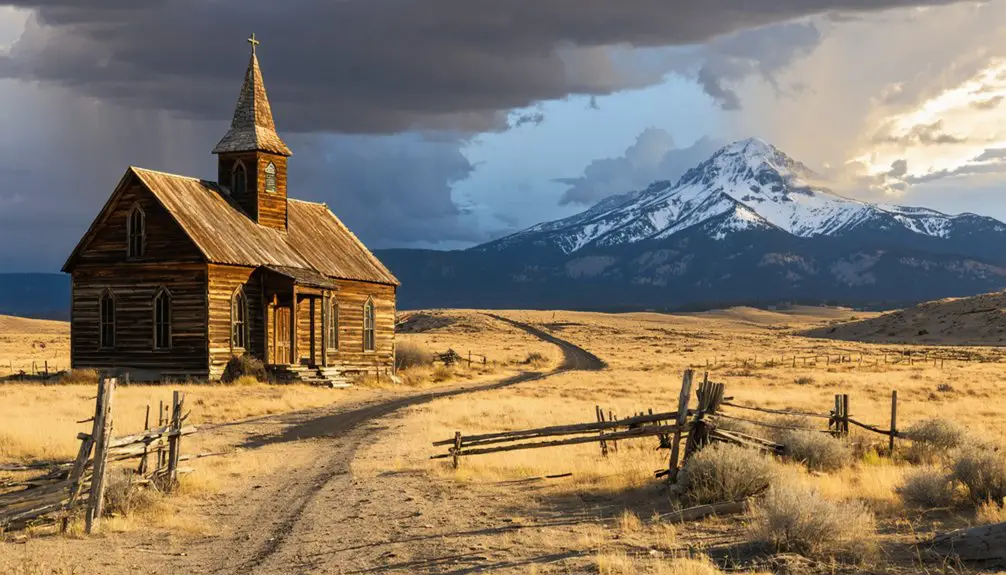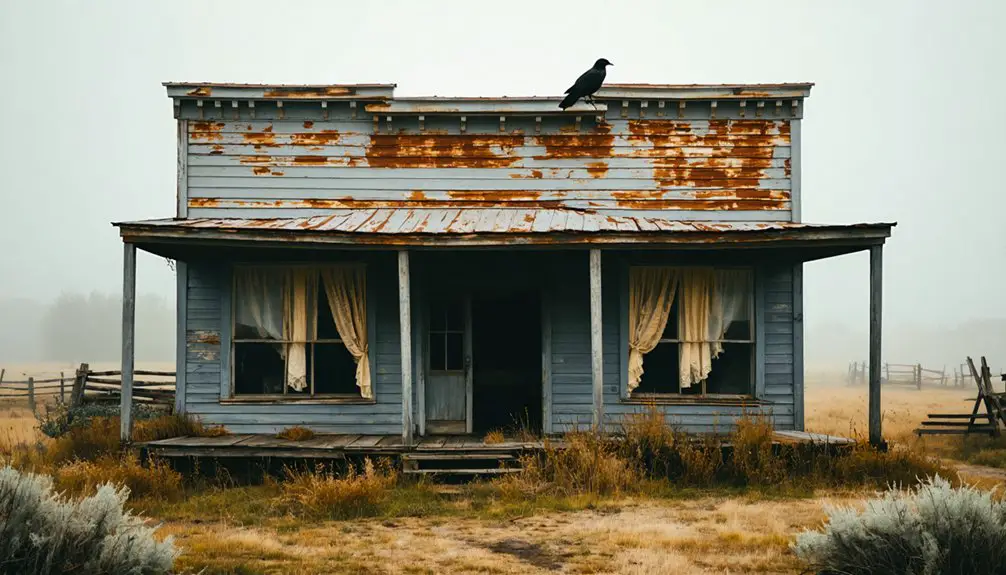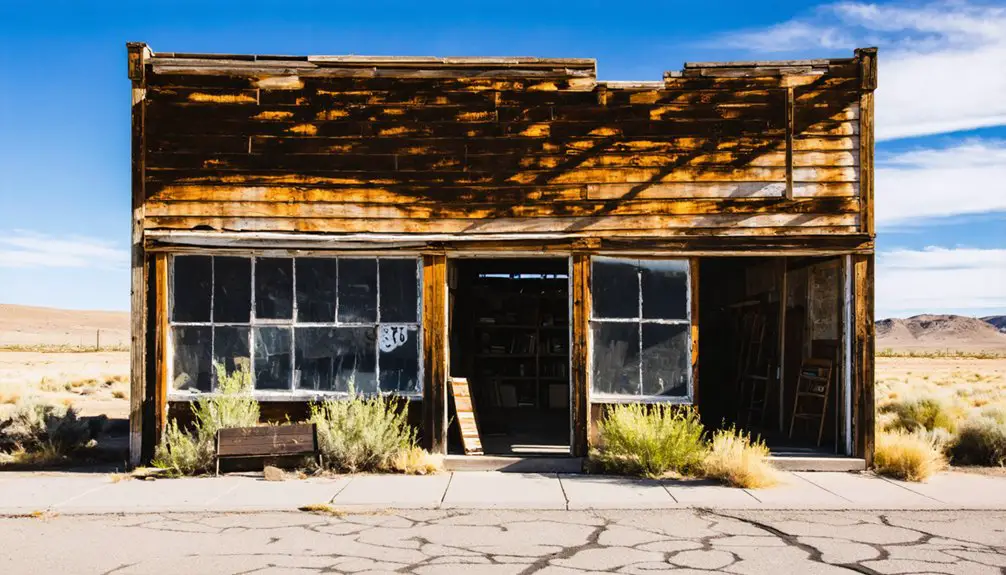You’ll discover Ashwood, Oregon in Jefferson County’s remote high desert, where silver mining dreams sparked a boomtown in 1898. The Oregon King mine anchored the community’s rapid growth, yielding over 230,000 ounces of silver and 2,400 ounces of gold between 1935-1950. Today, you can explore the ghostly remnants of early 20th-century mining structures, while volcanic formations like Ash Butte and mysterious local legends beckon curious adventurers deeper into its fascinating past.
Key Takeaways
- Ashwood, Oregon became a ghost town after its prosperous silver and gold mining operations, centered around the Oregon King mine, ceased in the mid-1900s.
- The town’s peak occurred between 1901-1902, driven by successful mining that produced 232,402 ounces of silver and 2,419 ounces of gold.
- Modern visitors can explore partially intact mining structures and foundations from the early 1900s through self-guided tours.
- The ghost town features local legends of supernatural occurrences, including spectral shopkeepers and phantom footsteps near abandoned buildings.
- Located near Trout Creek, Ashwood’s remains include historic mining tunnels, a post office established in 1898, and structures from its mining heyday.
Origins and Native Lands
Before becoming a ghost town, Ashwood occupied lands that served as borderlands between the mid-Columbia River Sahaptin peoples and Northern Paiute tribes.
You’ll find the area’s name comes from Ash Butte, a volcanic formation that dominated the landscape where these indigenous peoples maintained their Native Rights for thousands of years.
Both tribes lived nomadically, following well-established seasonal patterns across the region. The Northern Paiute’s seasonal migration patterns were dictated by the movement of animals and availability of natural resources.
Following ancient rhythms of the land, these indigenous peoples moved with purpose through familiar territories as seasons changed.
Their Cultural Heritage embraced a communal approach to land use, with shared access to hunting grounds, gathering sites, and trading areas.
They created extensive trail networks that connected various parts of Oregon, facilitating commerce and communication.
Women and men held distinct roles in sustaining their communities through hunting, fishing, and harvesting medicinal plants along the rivers and wetlands that nourished their traditional way of life.
The forced relocation to Warmsprings of the Sahaptin peoples in the 1850s marked a devastating disruption to their ancestral connections to the land.
The Birth of a Mining Frontier
You’ll find the origins of Ashwood’s mining frontier in 1898, when local sheepherders discovered rich silver ore at what would become the Oregon King mine.
The discovery sparked a rapid expansion of mining claims across the area, including promising prospects like Antelope, Gold King, and White Butte, while attracting waves of prospectors and mining companies to the previously ranching-focused region. Historical mining sites remain visible throughout the area today.
Early development faced significant hurdles, including a costly three-year litigation over the Oregon King claim that cost participants $40,000, yet mining operations persisted as shaft depths reached 500 feet by the early 1900s. A post office established in 1898 marked the official beginning of the settlement.
Silver Strike Sparks Growth
During the dawn of the 20th century, local farmers and sheepherders stumbled upon mineral-rich quartz and sulphate ores near Ashwood, Oregon, igniting a silver and gold rush that would transform the region.
The silver discovery at the Oregon King mine proved particularly significant, with its shaft eventually reaching 500 feet below ground. You’ll find that this discovery sparked a wave of additional claims, including the Antelope, Gold King, and White Butte prospects. Today, these abandoned mines stand as testament to Ashwood’s status as a historical ghost town.
The mining impact radically shifted Ashwood’s economic focus from ranching to mining. While legal battles over competing claims delayed development for three years and cost $40,000, the Oregon King mine eventually flourished.
Between 1935 and 1950, it yielded an impressive 232,402 ounces of silver and 2,419 ounces of gold, forever cementing Ashwood’s place in Oregon’s mining history.
Early Miners Face Challenges
While silver and gold discoveries promised great wealth in Ashwood, early miners faced challenging obstacles that tested their resolve. You’d have found an environment where legal disputes over claims consumed time and money, with the Oregon King mine litigation alone costing $40,000 and lasting three years. The mining boom period transformed this central Oregon town into a bustling community of prospectors and settlers.
The remote location forced you to adapt to harsh conditions and limited resources. Similar to the miners in Bohemia mining district, you would have relied heavily on rugged trails to transport equipment and supplies.
- You needed to navigate complex mining technology challenges, including primitive ore-grinding methods and extensive tunneling to reach valuable deposits.
- You’d have dealt with transportation difficulties, hauling heavy equipment across makeshift boardwalks and sourcing timber from local sawmills.
- You’d have encountered social tensions between established ranchers and incoming miners, all competing for limited land and resources.
Peak Years and Economic Growth
During Ashwood’s peak in 1901-1902, you’d witness the Oregon King mine driving unprecedented economic growth while long-established ranching families expanded their sheep and cattle operations.
You’d see the convergence of mining entrepreneurs like J.G. Edwards and J.B. Cartwright with traditional ranchers, though their competing interests over land use often led to conflicts.
The town, established around 1870, developed into a significant regional hub for both mining and agriculture. You’d find the town’s dual economy at its height, with mining activities centered on gold and silver extraction while wool shipments continued through nearby Shaniko’s railroad connection. The town’s prosperity was brief, as mining operations ceased due to litigation problems with the Oregon King Mine.
Mining Drives Town Growth
As news of significant mineral discoveries spread across Oregon in 1901, Ashwood’s sleepy ranching community transformed into a bustling mining town. The Oregon King Mine led the charge, implementing advanced mining techniques that reached 500 feet below the surface. The discovery of silver and gold in 1910 further accelerated the town’s development.
You’d have witnessed an unprecedented economic boom as the town expanded to support the flourishing mineral industry.
Here’s what drove Ashwood’s explosive growth:
- Rich deposits of silver, gold, and copper attracted substantial investor interest
- New milling facilities and transport routes developed to handle ore processing
- Population surge brought diverse economic opportunities beyond traditional ranching
Despite legal battles over claims costing up to $40,000, the mining industry persevered.
Ranching Business Expands Operations
The decline of Ashwood’s mining industry in the early 1900s sparked an unexpected agricultural renaissance.
You’ll find that ranching innovations transformed the region as families acquired vast tracts of grazing land, with operations like Hay Creek and R2 Ranch leading the charge. These enterprises spanned tens of thousands of acres, incorporating sophisticated water management systems and extensive rangeland.
Irrigation advancements revolutionized the area’s potential, allowing ranchers to cultivate feed more effectively and support larger herds.
R2 Ranch exemplified this progress with its network of 150 improved springs, year-round creeks, and a 35-acre lake. The railroad connection to Shaniko opened crucial market access, while the Crooked River National Grassland’s 173,629 acres provided essential grazing resources that helped sustain Ashwood’s newfound ranching economy.
Daily Life in Early Ashwood
Life in early Ashwood centered around the harsh realities of scratching out a living from the arid Central Oregon landscape. Community dynamics reflected a blend of ranching families and mining workers who demonstrated remarkable economic resilience by diversifying their activities to survive.
Frontier resilience defined early Ashwood, where ranchers and miners adapted to harsh desert conditions through resourceful diversification.
You’d find the daily routines shaped by:
- Essential services centered around the post office established in 1898 and the local schoolhouse, which served as community gathering points.
- A mix of occupations including sheep ranching, mining work, and subsistence farming despite challenging conditions.
- Social interactions primarily revolving around ranching families and mining workers, with residents adapting to the boom-and-bust cycles that defined the town’s economy.
The town’s remote location near Trout Creek meant you’d need to be self-reliant while maintaining connections to the railroad hub at Shaniko for commerce.
Natural Wonders and Geological Treasures

Shaped by ancient volcanic forces, Ashwood’s natural landscape showcases remarkable geological treasures that you’ll find scattered across its rugged terrain.
You’ll discover distinctive volcanic formations like Ash Butte, a lapilli cone with its crater summit, and Lava Butte‘s massive basaltic flow dominating the horizon. At 2,526 feet elevation, the area reveals a complex volcanic history through its 4,000-foot-thick John Day Formation.
You can hunt for prized mineral specimens, including the area’s famous polka dot agates and thundereggs. While appearing ordinary on the outside, these thundereggs reveal stunning internal patterns when cut.
The fossil-rich Logan Butte, though restricted for preservation, stands as proof of the region’s rich geological heritage, while surrounding volcanic soils support the ranching that replaced the old mining operations.
The Decline of a Boomtown
After discovering the Oregon King vein‘s rich silver ore in 1898, Ashwood quickly transformed from a quiet settlement into a bustling boomtown.
You’d have witnessed a remarkable community adaptation as miners, merchants, and settlers poured in, establishing stores, blacksmith shops, and saloons to support the thriving mining operations.
The economic change away from mining became inevitable by the mid-1910s when the rich ore veins depleted.
Here’s what shaped Ashwood’s decline:
- The shift from mining to livestock raising and farming
- The construction of highways that bypassed the town, isolating it from major trade routes
- The exodus of younger generations seeking opportunities elsewhere
Legends and Local Stories

While the physical remnants of Ashwood’s mining heyday slowly crumbled, the town’s spiritual legacy grew stronger through its rich tapestry of supernatural tales and local folklore.
You’ll find stories of ghostly encounters near the Oregon King mine, where miners who perished during the silver boom are said to still wander the old tunnels. The town’s unique honor-system store adds to this mystique, with locals claiming a spectral shopkeeper watches over the premises.
Native American spiritual connections to the land, particularly around Ash Butte, interweave with tales of pioneer hardships and unexplained phenomena.
At night, you might hear phantom footsteps echoing through abandoned buildings or catch glimpses of shadowy figures – reminders of the souls who shaped Ashwood’s fascinating history.
Modern-Day Remnants and Tourism
Today’s visitors to Ashwood encounter a compelling blend of natural and historical remnants that tell the story of Oregon’s mining era.
You’ll find early 20th-century mining structures and foundations scattered across the landscape, while Ash Butte and Trout Creek frame this remote ghost town tourism destination.
For the adventurous explorer, Ashwood offers:
- Self-guided tours through partially intact mining structures dating to 1901-1902
- Photography opportunities of historic ranching infrastructure and volcanic formations
- Mountain biking and gravel riding routes through scenic historical landscapes
While historical preservation remains a challenge due to natural decay and limited management, you’re free to explore this authentic piece of Oregon’s past.
The site’s remote location and rugged access roads add to its appeal for off-the-beaten-path travelers seeking connection with the American West.
Frequently Asked Questions
Are There Any Surviving Photographs of Ashwood During Its Peak Years?
You’ll find some historical documentation, including a notable 1915 photograph and mining-related images in photographic archives, though most surviving pictures were taken after Ashwood’s economic peak around 1910.
What Happened to the Mining Equipment and Infrastructure After Abandonment?
Ever wonder what time erases? You’ll find the mining equipment was largely scrapped or scavenged for metal, while infrastructure decayed naturally. Buildings collapsed, and what remained was either sealed or dismantled by locals.
Did Any Families From the Original Settlement Remain in Ashwood?
You’ll find descendants’ stories reveal several original ranching families stayed after the mining bust, adapting their livelihoods and maintaining family legacies through ranching and farming well into the 20th century.
How Much Total Gold and Silver Was Extracted From Ashwood Mines?
You’ll find records showing mining history at Oregon King produced 2,419 ounces of gold and 232,402 ounces of silver, with gold extraction peaking between 1935-1950 before a shaft fire ended operations.
Were There Any Documented Conflicts Between Miners and Native American Tribes?
You’ll find few direct conflict accounts around Ashwood’s mines specifically, though tribal relations were tense following earlier forced removals of Sahaptin and Northern Paiute peoples before the area’s mining boom began.
References
- https://www.mpaxauthor.com/off-the-beaten-path-ashwood-oregon-naturephotography-naturebeauty-photography/
- https://westernmininghistory.com/towns/oregon/ashwood/
- https://www.oregonhistoryproject.org/articles/historical-records/ashwood-1915/
- https://en.wikipedia.org/wiki/List_of_ghost_towns_in_Oregon
- https://dirtyfreehub.org/routes/oregon/ghost-of-ashwood/
- https://www.youtube.com/watch?v=xKBN2SJX0AU
- http://www.photographoregon.com/Ashwood-Oregon.html
- https://mounthoodhistory.com/mount-hood/mount-hoods-native-people/
- https://pacificu.libguides.com/c.php?g=1050460&p=7636236
- https://jeffcohistorical.org/wp-content/uploads/2019/04/Spring-Agate.pdf



